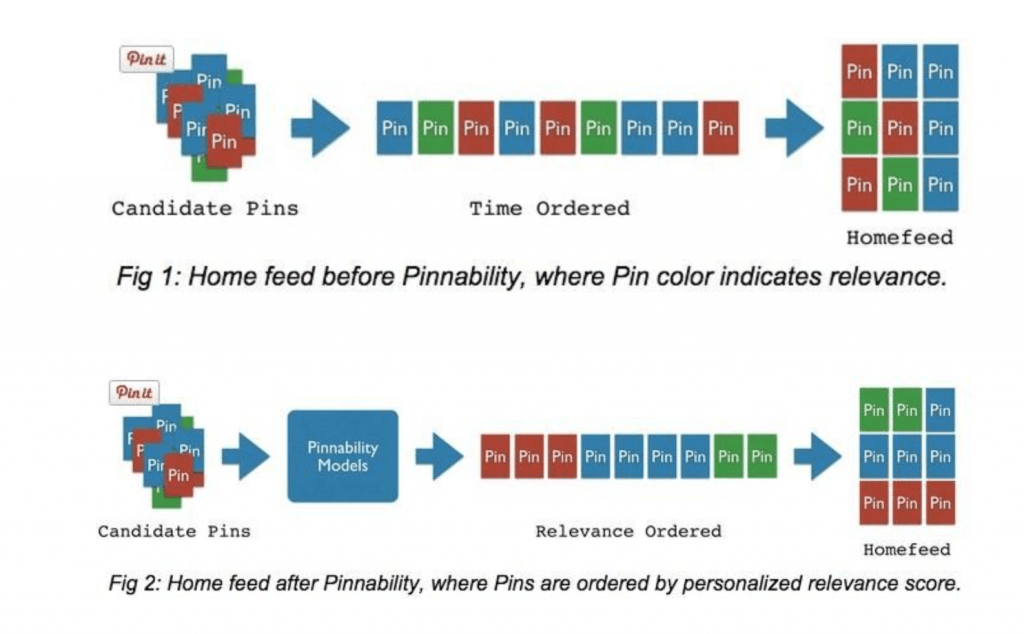How Pinterest uses machine learning to provide tailored recommendations to million of users worldwide.

Pinterest uses machine learning to identify content in line with items previously pinned by users and to recommend new products to its users.
Pinterest is a social network and image sharing service where people discover and save images, that in August 2020 had more than 400 million monthly active users[1] saving more than 240 billion of pins[2]. From increasing the precision of its ad targeting to recommending better pins[3] the appears on the users’ home pages, machine learning is crucial for Pinterest. As noted by Vijay Narayanan, Pinterest’s Head of Discovery and Content, “there are AI projects focused on things like self-driving cars, but there’s also the everyday, accessible AI that helps people live better lives now”[4].
Pinterest realized the importance of AI already in 2015, when it acquired Kosei, a machine learning start up that specialized in a technology that drives content discovery and makes highly personalized product recommendations, through recommendation algorithms and a system containing 400 million of linkages between billion of products[5].
Pinterest uses machine learning to identify content in line with items previously pinned by users and to recommend new products to its users. Its algorithms therefore inspire people by proposing them items that they might not have been initially searched.
Technology with a purpose
Pinterest motto is to develop technology with a purpose: accessible AI should be able to solve an identified problem. Indeed, the company’s mission is “to help people discover and do what they love[6]. Therefore, Pinterest uses a learning model that, by understanding the intentions behind uses research is able to deliver highly personalized results. This personalization is the main value creation component of the company. Indeed, 80 percent of Internet users are likely to make a purchase if their experience is personalized[7].
The Discovery Problem
In order to assess the users’ intention, Pinterest had to disentangle the “discovery” problem, understand what people are looking for from the three or less words they input in the search bar. While the number of Pinterest users grows and the number of items saved has crossed 100B, Pinterest need to “build technology to not only keep up, but make recommendations smarter”[8]. Therefore, it developed PinSage, a neural network placing each image, according to a specific theme, within a graph of other images. It allows building a context for each imagine, through which Pinterest offers thematic visual recommendation to its users. In turn, thanks to PinSage, instead of a list of results, people receive a guide of personalized recommendations.
Machine learning in the home feed through Pinnability
The growing number of saved items posed another crucial challenge: How does Pinterest surface the most personalized and relevant pins? Pinterest developed Pinnability, a collection of machine learning models that support users in find the most relevant content in their home feed. Pinnability “estimates the relevance score of how likely a Pinner will interact with a Pin”[9] and it allows accurate predictions, through which the Pinterest team prioritizes Pins based on a relevance score. Therefore, Pins are not showed anymore in a chronological order as it used to be.
Engagement Abroad
Initially, Pinterest’s machine learning models were not targeted for users outside the United States, so that people with similar items saved in different countries had a similar prediction score. However, Pinterest realized that its models should be changed to expand outreach to users abroad, and designed a language detection model bases on country and language match features, including “whether the Pinner’s language and country are the same as a Pin’s language and country, and if the Pinner’s language is among the top languages spoken by others who saved the Pin”[10]. Using this method, Pinterest improved the number of items saved by international users by 10 to 20 percent[11].
The Future
In order to leveraging on its technology, Pinterest is using machine learning for a number of other applications and operations, such as for eliminating harmful and negative content from the platform, detecting spam content, executing ad performance and relevance prediction analysis. However, to win the competition with other social media which are entering the realm of targeted ad, such as Instagram, Pinterest needs to continue investing resources in research and development to design cutting-edge iterations of its model able to offer customized recommendations to its users.
[1] Fiegerman, Seth. 2020. “More than 400 million users around the world connect to Pinterest each month (Number of the day)” in CNN Blog, August 3, 2020, Available at: CNN https://news.yahoo.com/more-400-million-users-around-world-connect-pinterest-153930499.html
[2] Pinterest website. Available at: https://newsroom.pinterest.com/en/company
[3] Pins are bookmarks that people use to save ideas they love on Pinterest.
[4] Wired. 201. How Pinterest uses AI to capture our imagination. Available at: https://www.wired.com/brandlab/2018/11/pinterest-uses-ai-capture-imaginations/
[5] Constine, Josh. 2015. “Pinterest Acquires Machine Learning Commerce Recommendation Engine Kosei” in TechCrunch, January 21, 2015. Available at: https://techcrunch.com/2015/01/21/facebook-past-google-present-pinterest-future/
[6] Pinterest website. Available at: https://newsroom.pinterest.com/en/company
[7] Wired, cit.
[8] Pinterest Engineering Blog. 2018. PinSage: A new graph convolutional neural network for web-scale recommender systems. Available at: https://medium.com/pinterest-engineering/pinsage-a-new-graph-convolutional-neural-network-for-web-scale-recommender-systems-88795a107f48
[9] Pinterest Engineering Blog. 2015. Pinnability: Machine learning in the home feed. Available at: https://medium.com/pinterest-engineering/pinnability-machine-learning-in-the-home-feed-64be2074bf60
[10] Pinterest Engineering Blog. 2017. How machine learning significantly improves engagement abroad. Available at: https://medium.com/pinterest-engineering/how-machine-learning-significantly-improves-engagement-abroad-98c6ca937f9f
[11] Ibidem.





Thanks Giulia for this interesting blog. Not being a social media addict myself, I am still confused on the unique value proposition of Pinterest compared to, for instance, Instagram or Facebook. As a result, and based on what you wrote above, how could Pinterest have leveraged its AI-technology (and other best practises in the digital transformation area) in a better way? Today, Pinterest (although financially a very solid company) has only half of the individual users of Instagram. How come?
Thanks for the article, Giulia. In response to Tim’s comment above, Pinterest has a much more specific role than an instagram. As a user of Pinterest, I know that it serves a completely different purpose than an Instagram or Facebook. It is not a social place to share information with your friends. It is a place to look for ideas in a visual way. For example, if I want to redecorate my living room, I can use Pinterest to get very creative. For this reason, I would expect Pinterest to bring in the lower amount of users in comparison to Instagram.